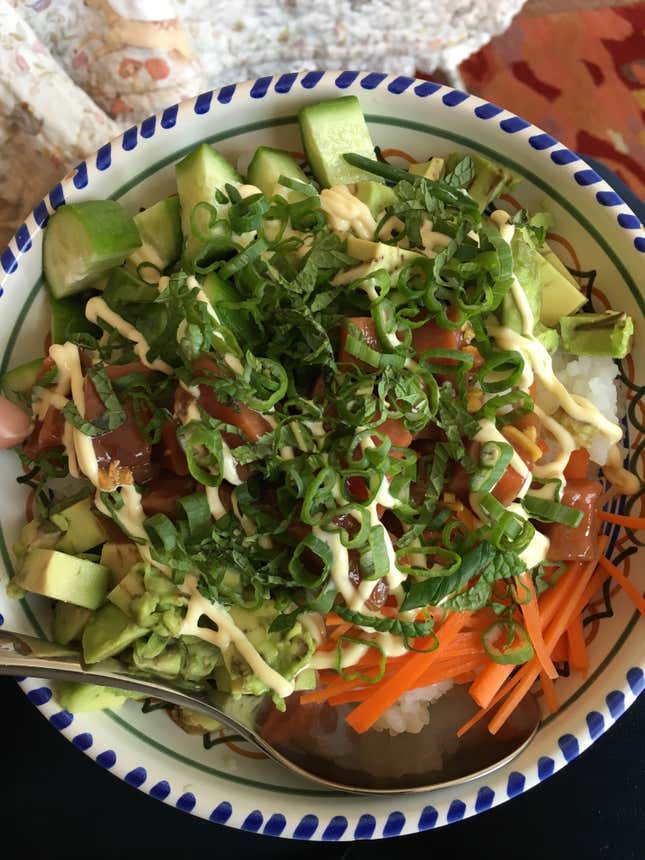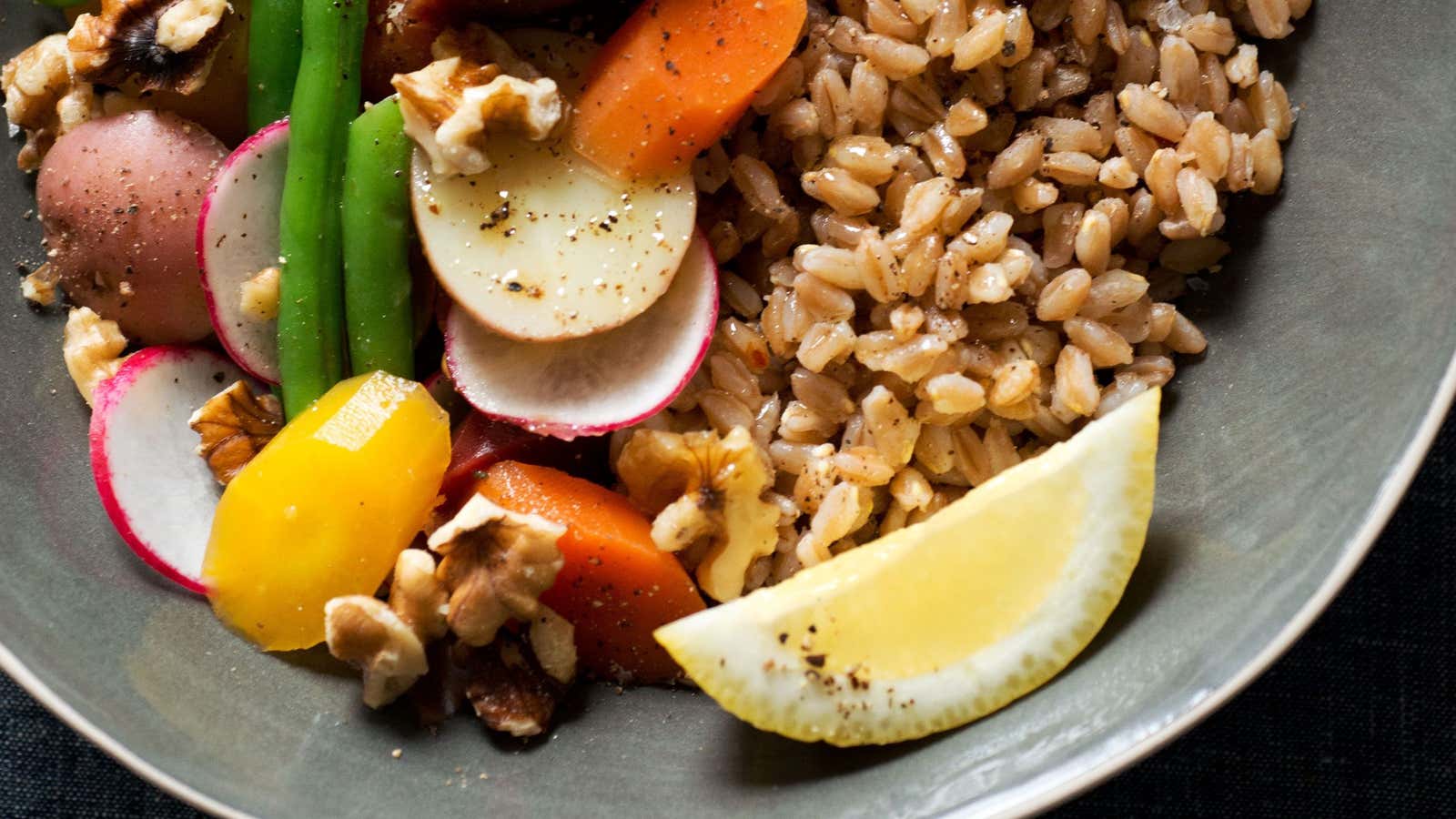There were only three uses for the blue and white Pfaltzgraf bowls that filled my family’s kitchen cabinets when I was growing up—soup, breakfast cereal, and ice cream. Okay, maybe the occasional chili night. Everything else—pasta, casseroles, roast chicken—we ate off of large dinner plates, offset by smaller salad plates. Today, however, when I serve dinner to my own children the table looks much different. There are no small plates, and more often than not everyone simply eats out of a bowl.
Grain bowls, harvest bowls, Buddha bowls, smoothie bowls, burrito bowls, poke bowls, KFC mashed potato bowls—from obsessively healthy super foods, to “cheat-day” fried chicken, we’re eating more food than ever out of bowls. And we’re filling them with a new style of layered grains and vegetables—one with less meat and more flavors.
After a century as a supporting player on the American tablescape, bowls are now getting the main attractions of many meals— commonly filled with ingredients that would have raised eyebrows a generation ago, like quinoa, hemp nuts, and massaged kale. It’s not surprising that the bowl has been elevated in an era obsessed with culinary authenticity and healthy alternatives—but how exactly did the bowl go from porridge to poke?

Bowls, a recent history
“For most cuisines of the world, the bowl is the primary vessel for eating,” explains Matthew Weingarten, culinary director at Dig Inn, a bowl food-centric fast casual chain, in a recent phone interview. “It evokes a way of eating that for me is more about something of comfort and sustenance.” That sentiment probably rings true for many modern diners, with our casual meals and “glocal” focus on flavors and dining styles. But it’s a relatively new way of looking at food.
In twentieth century America, plates dominated the dinner table: One for bread, one for salad, one for the main course and another for dessert. In fact, many middle class families had two sets of china, an everyday pattern and the fancier plates for guests and special occasions. Much like in my house, bowls were used mostly for wet foods like soup, or for informal meals like breakfast cereal.
Using many plates and bowls—along with even more specialized items like fish knives and asparagus plates—reflected the traditional interest in keeping food separate, says Helen Zoe Veit, a historian who studies food, and associate professor of history at Michigan State University. Bowls meant mixing foods—which was not how eating was to be done.
“The concept of the bowl meal was very unfashionable for much of the twentieth century,” Veit said in a phone interview. “In fact, a lot of Americans in the twentieth century spent a lot of time and effort distinguishing themselves from that kind of eating…they had lots of courses, lots of tableware dedicated to specific foods or food groups.”
How we were eating was reflective of what we were eating, and that tended, in mainstream American culture, to be a slab of protein with a couple sides, salad and bread. “(This) sort of extreme separation of meal components…is seen as a mark of refinement and education and status,” Veit said. “Americans for a long time were sort of saying…that mixtures are a little disgusting.”
Formal plates with discrete piles of food were symbols of American identity and wealth, one of the many spoils of capitalism and the rising middle class. Bowl food was sidelined as too closely associated with the poor, with unassimilated immigrants and their unfamiliar cuisines. It’s no surprise then that when the Diggers set out to loosen the constraints of capitalist society in San Francisco in the 1960s, they set about it not just with guerrilla theater and political actions, but with free food.
“Good hot stew, ripe tomatoes, fresh fruit. Bring a bowl and spoon to the panhandle at Ashbury Street…It’s free because it’s yours,” read flyers the Diggers passed out in 1966. A bowl wasn’t just a vessel, it was a bohemian essential, and bowl food was the diet of the revolution.
Back up, what is bowl food?
Part of the appeal of the bowl is that you can eat almost anything out of it. Noodles, dumplings, soups of all kinds, these are eaten out of a bowl by necessity, but a whole other category of “bowl food” has come to prominence in the past decade or so—dishes that could be enjoyed on a plate, but would seem much less coherent served on one.
We’re talking a base layer of whole grains, or greens, or spiralized vegetables, topped with hearty components like roasted squash, grilled chicken, or charred brussels spouts, then sprinkled with fresh garnishes like green onions, and herbs, and finished with a sauce to tie it all together. Yogurt, granola, fruit, and nuts, combined with trendy ingredients like açai, chia seeds, and hemp nuts make up the breakfast branch of the bowl food family, joining more traditional items like oatmeal and porridge, which has also been fancied up, belying its Oliver Twist associations.
Though they are substantial enough for dinner, grain bowls are staples at new fast casual chains built on the concept of using seasonal produce to make healthy and delicious anytime meals, like Sweetgreen, Dig Inn and Tender Greens. They reflect the very real struggle to eat more vegetables and whole grains, and are a logical evolution of the luxe salad bar and the customize-your-dish set-up at fast food restaurants like Subway and Chipotle—which is itself an excellent example of the transformative power of the bowl.
If not for the vessel, what would you call the burrito bowl—the guts of a burrito, served layered over rice—at Chipotle? A tortilla-less burrito just doesn’t have the same ring and highlights the idea that you’re giving something up by ordering it. A burrito bowl on the other hand sounds like you’re manifesting abundance—in more than one culture.
Bowls give us the feels
The tableware we use influences the way we experience the food we eat. When we sit down to a meal, says Professor Charles Spence, Professor of Experimental Psychology and Head of the Crossmodal Research Laboratory at Oxford, our brain forms a basic set of expectations about how it will taste and how satisfying it will be. Elements like lighting, music, tableware all contribute to this baseline in a much bigger way than we realize. “Our brains try to predict the world around them,” he said in a phone interview. “They try to predict the flavor of food.”
A bowl that we pick up and touch is more likely to set an expectation of a hearty, filling and healthy meal, he said. “That weight in the hand is likely to make your brain think the food is more substantial and you’re likely to rate it as more intensely fragranced and aromatic than for exactly the same food sat passively on a plate,” Spence explained.
There’s an intimacy in eating from a bowl, that just isn’t there when you use a plate. This is part of the appeal of a bowl-centric menu, like the one at Dig Inn. “If you think of the sort of formality of the plate, and cutting with a fork and knife, everything is very rigid,” Weingarten said. “You pick up a bowl and bring it closer to yourself, and you can really enjoy it and immerse yourself and what’s in front of you. In many ways I think it’s one of the oldest ways to eat and at the same time, in this day and age, a lot of folks are looking for comfort and recognition of sustenance.”
They don’t just feel good in the hand, bowls are also beautiful. “This might tie in to the Instagramification of food,” said Lukas Volger, a vegetarian cook and author of the cookbook Bowl. “As bowls have been taking off there’s also a renewed interest in locally made pottery, bringing the beauty of bowl into the visual experience, of food.” Restaurants like Takumen, a ramen bar and design-centric izakaya in New York City, have incorporated custom-made bowls into the aesthetics of their menu and interior.
Eating out of a bowl may even make the world feel friendlier.
“If you hold the bowl then you feel its warmth, if it’s a hot dish,” Spence said. “There is research out there showing that if you feel something warm in your hand the world looks like a better place.”

Bowl food is how we eat now
The American impression that mixtures are a little disgusting didn’t come out of nowhere. It arose in opposition to immigrant cuisine and foods of privation, thrifty dishes like stews and goulash, rice-based meals. “The bowl naturally stretches proteins whether that’s meat or whether that’s beans or eggs or something else and it lends itself to potentially using up little odds and ends that might otherwise be tossed,” Veit said.
By the 1920s, these mixtures—which made use of every scrap of food in the house—were singled out as being unhealthy by the very new, yet already deeply confused, field of nutrition. Too many different items eaten at the same time would confuse the stomach and lead to improper digestion, or so the theory went.
“People were translating, I think, their prejudices into scientific language, and they were saying digestibility is key for how our bodies deal with food,” she said. A culinary eugenics you might have called it.
Being able to customize bowl food, whether that means repurposing leftovers, or setting out a variety of components for compose-your-own-bowls makes it easier to eat more vegetables—both for home cooks and in restaurants. In the same way the bowl gets away from the custom of making a meal out of a protein and two sides, it also allows cooks to prepare components simply, without relying on specific, elaborate (and often restrictive) recipes, like a vegetarian lasagna, or even a composed salad.
Weingarten told me that Dig Inn started out with a different dining model, one that favored discrete (AKA separated) dishes, but that they had moved to a bowl food concept after realizing that it allowed them to serve more vegetables. For him, bowls are “a very organic, natural way of building a meal.”
At around $10-15 a meal, eating at Dig Inn, or any other restaurant anchored around bowls full of seasonal produce, is very much an expression of conscientious capitalism, rather than a Diggers-style departure from the larger food system. If they were, at one time, a social revolution in meal form, bowls are now a personal affirmation in a vessel. Just like Weingarten’s simply prepared seasonal vegetables, eating out of bowls makes us feel like our best selves.
